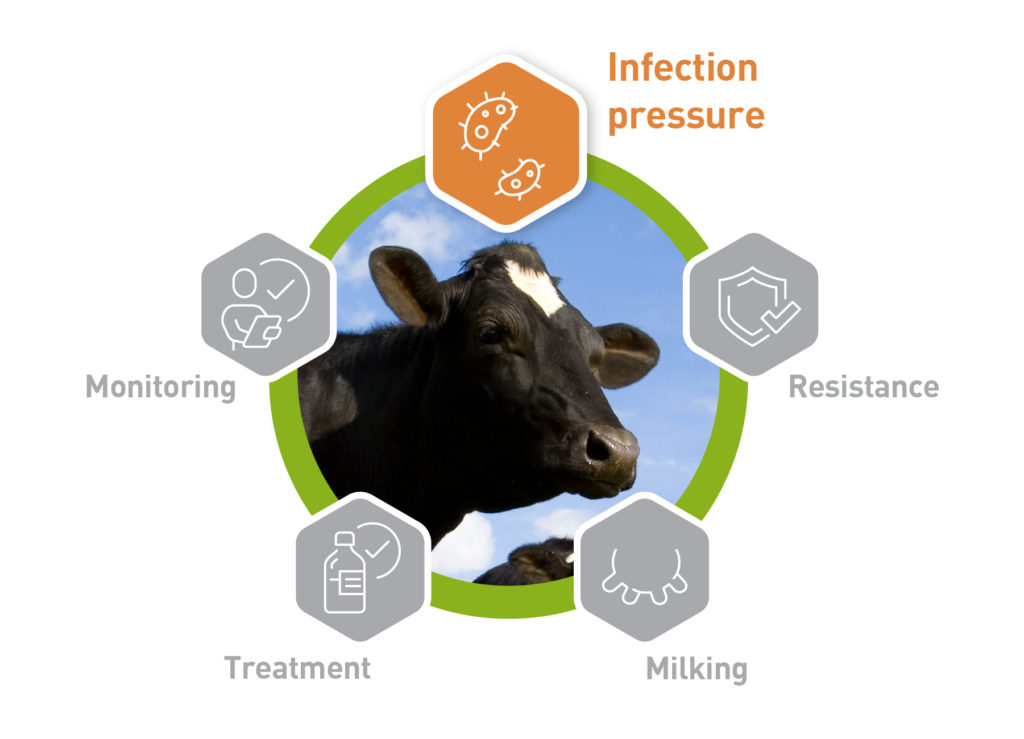
A cow that is reluctant to lie down will spend less time resting and more time standing, which can cause all sorts of problems.
See: the consequences of uncomfortable cubicles
Weaker cows are the first to suffer from poor cubicles – while they are the ones who really need their rest and comfort.

Housed cows are at greater risk for environmental mastitis than cows on pasture, and bedding materials are a significant source of teat end exposure to environmental pathogens.
This is why dry and bacteriologically safe bedding in resting places are essential to limit the infection pressure. And comfort is key for cows to lie down to rest and ruminate.
The three factors to consider with regards to bedding are therefore:
- It should be dry and cool
- It should harbour as few pathogens as possible
- It should be comfortable
This blog focuses on bedding of free-stalls, also called cubicles. In open barns with bedding consisting of deep straw or any other composting material, essentially the same rules apply: the bedding should be dry and free of pathogens. The temperature of deep litter should be monitored, as fermentation is highly correlated to the development of pathogens. Cow comfort in these barns is usually excellent, as there are no obstacles or concrete.
1. Cows love dry bedding
Cows have a strong preference for dry bedding, irrespective of age. Wet resting surfaces create stress amongst the cows because dominant cows will pick the driest spots.
A good rule of thumb is to kneel in the cow’s resting place: if your knees get wet, it’s not dry enough!
But it’s not just about comfort: bacteria thrive in moist environments, which is why dry bedding will also help reduce infection pressure.
Dry bedding is mostly obtained by adding extra bedding material regularly, at least once a day. Good ventilation will help remove moisture from both manure and urine, and from the exhalation air of the cows. Remember that a herd of lactating cows produce an immense amount of moisture via their respiration in order to lose body heat.
2. Low-bacterial bedding
When a cow lies down, her udder and teat are in direct contact with the surface of the resting place. The bedding should both be dry and harbour as few potentially pathogenic bacteria as possible.
In practice, bedding will rapidly become contaminated with manure and bacteria from other sources. Yet the right type of bedding – and regular renewal – will help reduce infection pressure.
Environmental conditions that can increase exposure to pathogens include overcrowding, poor ventilation, inadequate manure removal, hollowed-out free stalls and access to ponds or muddy areas.
Some types of material are more prone to harbouring bacteria, but it is generally accepted that clean inorganic materials are better to prevent mastitis and should be used, wherever possible.
=> See Top bedding choices for dairy cows
3. Cow comfort is key!
A free stall or cubicle is a compromise between cow comfort and hygiene. As cows drop their faeces and manure where they are standing, standing cows mean dirty beds, therefore the cubicle should provide all the comfort that the cows need to lie down and rest as often and as much as they want which will prevent dirty beds!
- See lying comfort scorecard
Top bedding choices for dairy cows
The most important component of cubicles is the floor: the bed plus bedding. This should be very soft and dry. Soft to give the cow a comfortable landing and lying surface, plus to provide her with excellent grip for her feet during lying down and getting up.

Top bedding choices:
- Sand
- Deep bedding with organic material
- Mattress & bedding
Sand is by far the best bedding material for cubicles. As an inert material, it doesn’t provide a substrate for pathogens, helping to keep down infection pressure. Cow comfort is better and lying times are longer, leading to increased milk yields. It also allows urine to drain better.
In second place come different types of other deep bedding with organic material, such as saw dust, straw, ground flax and rape, lime-water-straw mixtures or dry manure solids. As the temperature of the litter is highly correlated to the development of pathogens, it should be controlled. In deep bedding, it is advised to maintain the litter temperature under 25 °C at the surface, or under 36 °C 10 cm deep.
Mattresses come in third position. There’s a wide choice of mattresses on the market, ranging from good to really bad. Good mattresses are soft and provide good grip for the hooves of the cow and stay soft over their lifespan. Mattresses wear out however and lose their softness over time.
You can test the softness with the so-called “knee-test”, and you can test the abrasiveness of the mattress surface with the so-called “back of hand rub”.
=>See lying comfort scorecard
However, mattresses alone are not enough and do not replace bedding material. It is therefore essential to add bedding material, which will help them stay clean and comfortable.
Cubicles: cleaning tips
All deep bedded and mattress-bedded cubicles need to be managed well:
- 4 x per day clean and even out the bedding (barn round)
- during 1 or 2 of these barn rounds: deep cleaning and addition of dry bedding
- 1 x per week fill up with fresh bedding. The bedding surface should stay above the curb of the cubicle
If the beds are too wet and dirty, what should we recommend?
- Improve the frequency/intensity of cleaning and the adding of bedding materials
- Add specific bedding materials that make the bedding drier and have anti-bacteriological effects (e.g. lime)
- Check and improve ventilation
- Do a bacterial culture of bedding samples. If the bedding is infected: empty the beds and start again with fresh clean bedding
- Observe resting behaviour of the cows:
- if the cows are not lying straight in the beds but at an angle, this means they do not have enough space: check head-swing space, total length of the stall, length of the bed (curb to brisket locator), and position of the neck rail
- if the cows are lying straight in the beds and too many cows seem to drop manure in the bed: put the neck rail a little bit further backwards, to keep the cows from dropping manure in the cubicles
Consequences of uncomfortable cubicles
If the cubicles are not comfortable enough – too short, not enough head room, wet bedding…– the cows will not rest as much as they want and need to. This will lead to:
1.Reduced milk production
When a cow wants to lie down but can’t, she experiences stress. Stress leads to higher cortisone levels in the blood, which reduces milk production.
A cow lying down will ruminate more which increases feed efficiency, i.e. the milk per kg of dry matter intake. In a recumbent cow, the blood circulation through the udder is better than if she’s standing.
2. Increase in foot problems
Too much standing leads to solar haemorrhages, that can develop into solar ulcers. In uncomfortable cubicles, the cows are often standing with their hind legs in the wet and dirty area directly behind the curb. This is not only a risk for dirty udders if she eventually does lie down but will also lead to digital infections.
3. Higher risk of injuries
Inadequate cubicles will increase the risk of injuries, in particular of the hocks, knees, ribs and pin bones. Infected wounds require energy to heal, are painful, and are a risk factor for other diseases.
Monitoring and problem shooting
Monitor the hygiene and comfort of the resting places by:
1. Observing the behaviour of the cows
In particular pay attention to the cow’s behaviour during lying down, resting, and standing. Can she swing her head forward? Is the floor slippery? Does she prefer to remain standing?
2. Hygiene scoring
See What cows can tell us about farm hygiene
⇨ Use the hygiene score card in VetIMPRESS/Multi Data/Cleanliness or from AHDB at
3. Hock scoring
Asses the hock score
4. Milk sample analysis
Take a milk sample from the cow or the milk tank to assess the relevance of environmental udder pathogens.
=>Testing milk samples: the key to mastitis control
